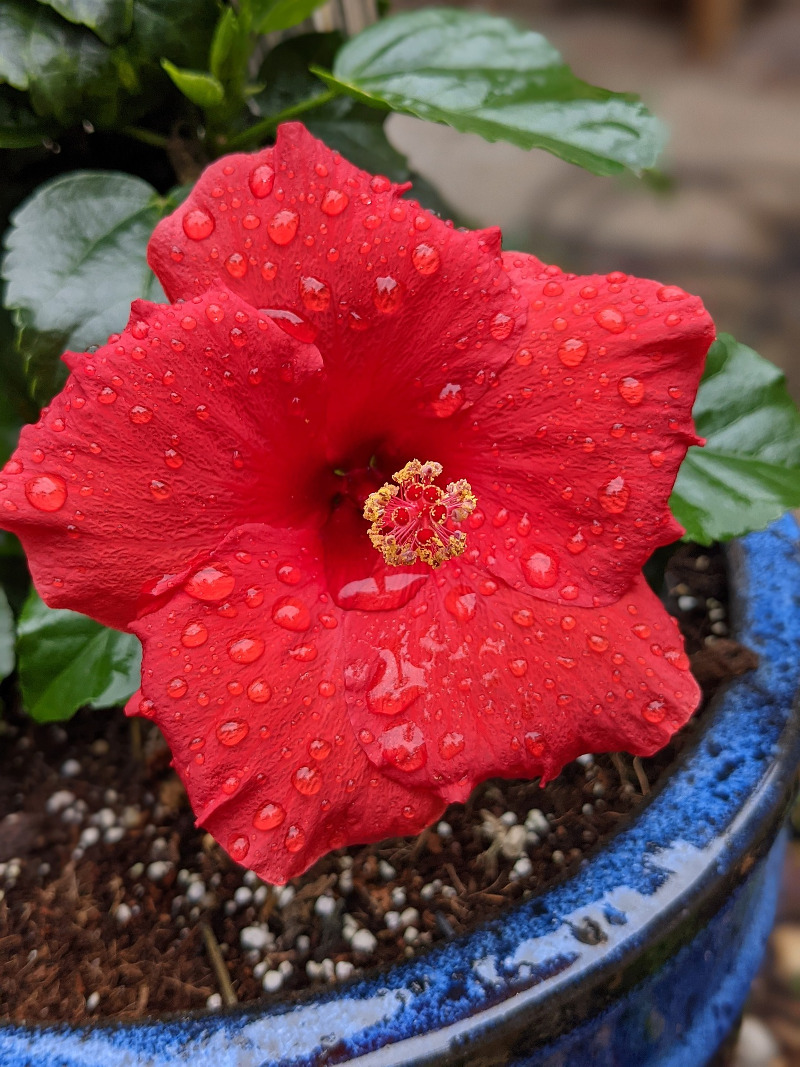The tropical-looking flowers of the Hibiscus create a warm-weather vibe and make this perennial a favorite of many. There are two varieties of Hibiscus: hardy and tropical. Hardy Hibiscus is better suited for USDA growing zones 4 through 8. With proper care, these plants can grow very large. Hardy Hibiscus can quickly outgrow a container, and they naturally go dormant during the colder months, so it is not common to grow this variety in a pot.

Tropical Hibiscus can live outdoors year-round in growing zones 9 through 11. If you live in a cold climate, you can grow a tropical Hibiscus in a pot and bring it inside for the winter. Container living may stunt the growth of your Hibiscus, but you will be able to enjoy this beautiful plant year-round.
Planting Hibiscus in Pots
The best time of year to plant Hibiscus in pots is in the spring. If you plan to bring your tropical Hibiscus inside for the winter, then you may want to consider leaving it in a container all year. Making the transition from ground to pot can be challenging. Growing the plant in a container all year will minimize stress and make it easier to acclimate to indoor living after a summer spent outside.

Hibiscus do well in most types of planters. Plastic is a good option since it is lightweight, and the plant will likely grow to be rather big, so it may be easier to move the plant if it calls a plastic container home. Although, if you prefer the aesthetic of terracotta and ceramic, that works well for Hibiscus, too. As long as the pot has drainage and is a few inches larger than the root ball, it is suitable for Hibiscus.
Best Soil For Hibiscus in Pots
Hibiscus plants need well-draining, slightly acidic soil. You can amend the soil with compost or slow-release fertilizer to help the Hibiscus thrive.
Caring For Hibiscus in Planters
Other than more frequent watering, Hibiscus in planters requires very similar care to what would be necessary for a plant in the ground. The planter should be in an area that receives a minimum of 6 hours of sunlight each day. If the plant is near a structure, tree, or anything that blocks sunlight, make sure to rotate the pot once a week to ensure each side receives even sunlight. You may want to select a spot with partial shade in areas with very high temperatures to protect the plant from overheating.
Watering Hibiscus in Pots
Hibiscus plants in pots need water when the top couple of inches of soil are just barely wet. Do not let the soil completely dry out, and drench the soil until excess water comes out of the drainage holes. Planter-grown Hibiscus typically need to be watered every couple of days, depending on the weather.

Fertilizing Hibiscus in Pots
Select a fertilizer high in nitrogen and potassium for container-grown Hibiscus. Regular feedings will help the plant push out glossy foliage and stunning flowers. Use a water-soluble fertilizer every other week or apply a slow-release fertilizer in the early spring, after the first round of flowers die back, midsummer, and lastly, during the early winter.
Winter Care For Hibiscus in Pots
Tropical Hibiscus can live very comfortably outdoors during the winter in zones 9 through 11. In the rare instance of a cold snap, cover the Hibiscus to protect it or move it to a sheltered area like in your home or even in a garage. The roots of Hibiscus in pots are more susceptible to cold temperatures, so if the temperature is forecast to be chilly, especially if you live in zone 9, but maybe close to the border with zone 8, you may want to bring the container inside.
In colder areas, Hibiscus in pots will need to spend the entire winter indoors. Place the plant in an area that gets lots of sunlight and has increased humidity. The plant may go dormant, and if this happens, scale back on how often you water until new growth starts to emerge.
Can Hibiscus Be Grown Indoors
Hibiscus can be grown indoors, but the plant may not thrive the way it would outdoors. Hibiscus plants require lots of bright sunlight, warm temperatures, and increased humidity. Typically, the conditions in a home may not completely align with what the plant needs to bloom and thrive. However, the conditions in most homes will allow the plant to survive during the winter.
 |
Author Alison Cotsonas - Published 12-13-2021 |
